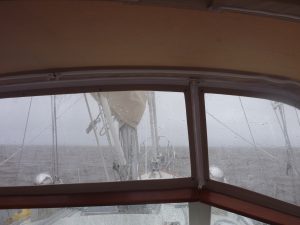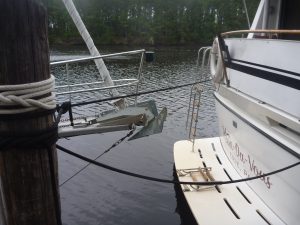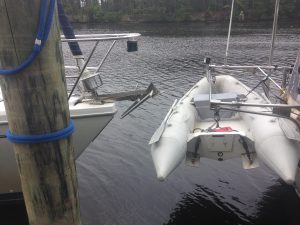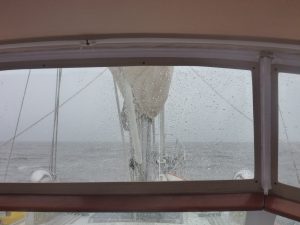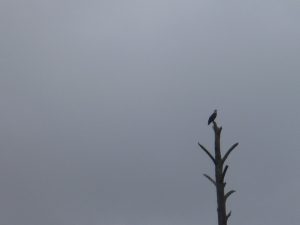7 May – Great Bridge, VA to Hampton, VA
Goodbye ICW
We ended up staying in Great Bridge a second day because the weather forecast was for rain, rain, rain. We were still hoping one of the other boats in front or behind us would leave first. But no such luck, as we woke up today with both neighbors still in place.
We prepared to leave the dock in order to make the 0800 opening of the Great Bridge Bridge.
The engine started easily as it had gotten a full charge from the shore power overnight, so that was a bit of good news.
First challenge of the day was how the heck are we going to get out of the slip. The wind driven current seemed to be in our favor, and the owners of the boat behind us assisted with our dock lines from the dock. They untied the bow line and the bow just drifted away from the dock. The spring line was next while our neighbor pushed the stern out so the dinghy would clear the pilings on the dock. And with what appeared to be a very easy maneuver Bob slid us safely away from boats and dock.
We had 15 minutes to wait before the bridge opening and basically had to sit still in the river which is always a challenge. There were at least 6 other boats waiting for the bridge at the same time. But thankfully there is not any real current and Bob was able to keep us at a standstill without too much stress or challenge.
Immediately after the bridge is the only lock of this Northbound route we are on. The lock is timed with the bridge opening so we knew we would be proceeding into the lock directly. If we were tied up on the port side the wall was rubberized and fenders were not essential. However, if we were tied up on the starboard side wall, fenders were necessary to protect the boat. Of course we wouldn’t know which side we would be assigned to until we got there, so we took advantage of the “wait” time at the bridge to prepare the starboard side of the boat by tying 4 fenders and the fender board (a piece of wood that is placed to span two rubber fenders hanging from the life lines to give more horizontal protection). And one fender on port side. Dock lines were out and could easily be attached to either side.
We then heard on the radio a large tug boat was approaching and asking the bridge tender to hold the bridge for him, which he obliged. Everyone caters to the large tugs.
Finally the bridge went up and on we go. As we approach the lock, there appears to be enough space on the port side wall, and we head that way, handing the bow and stern dock lines to the lock tender ass he loops them over the lock cleats and hands us the free ends. (Lock lesson in case you don’t remember from our trip south…. the lock is a basin where they either fill with water or drain of water so boats can transit the channel with different depths on either end.)
With today’s lock we would be rising a mere 4 feet/1.2 meters. As we were now prepared for the process, Christina busied herself moving a couple fenders from the starboard side to the port side just to give the boat a bit more protection from the padded wall.
Remember that big tug at the bridge? Well he too is coming through the lock and begins to make his way in when the lock tender yells at him to back off a couple of times. The lock tender declares that recreational boats come in first and leave first or else the tug would create too much wake/movement and cause potential damage. We watched the tug begin to back up. But wait – there is a recreational power yacht right behind him! There were some quick maneuvers done by both and there was no major incident and the power vessel was finally able to make its way around the tug. I think the captain of the recreational boat got a bit of a scare though.
The tug finally made its way into the lock but as it made its turn toward the wall, the stern came uncomfortably close to the boat behind us (the same boat that was behind as at the marina last night). If it had been my boat I would have been a bit stressed as the sailboat folks could reach out and almost touch the tug before he brought the stern in toward the wall. That is alot of trust that the tug knew what he was doing.
The southend of the lock closed and the lock began to fill with water as we gently rose the 4’. Agreement was made to let the power vessels out of the lock first as they go faster than the sail boats, then the sail boats and finally the tug. All vessels proceeded out of the lock in an orderly fashion without incident and away we go to the next (and last) drawbridge of the day 5 miles away. 3 of the sailboats were moving significantly faster than us and pulled away quite a bit and approached the next bridge long before us.
Knowing that the bridge tender may be loathe to open the bridge twice in a short span of time, we radioed ahead when we we were just over a mile away (further out than usual) to let him know 2 more sailboats were coming and would be requesting an opening. This early communication served us well as the bridge tender told the other 3 sailboats he was going to wait for us and have us all pass on the same opening. Otherwise we would have had to wait for at least another half hour for a 2nd opening.
As we finally came into sight the bridge tender radioed us to “turn the screws a bit faster” and so we pushed the engine harder than normal to get up to the bridge more quickly. All went well as he raised the bridge and the first 3 boats proceeded as we barreled down (barreling down for us at least) to and through the bridge. We thanked the bridge tender for waiting for us and we continued on our way.
Shortly after this we passed mile marker 0 and officially left the ICW behind.
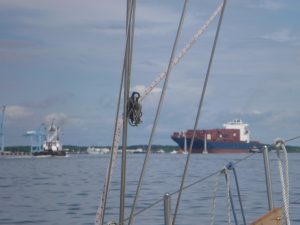 In the harbor we saw two sailboats apparently playing “chicken” with the large cargo ship. There was no harm done, but we really do wonder what some people are thinking sometimes.
In the harbor we saw two sailboats apparently playing “chicken” with the large cargo ship. There was no harm done, but we really do wonder what some people are thinking sometimes.
We meandered past Portsmouth and through Norfolk harbor to the Hampton River where we would be spending the next two nights. Two nights because the wind on Sunday was forecast to be strong from the north and we didn’t want to have to deal with it. Instead of the marina in the middle of downtown Hampton where we had stayed last time that had a nasty current which made docking a major challenge, we opted for another marina which was further from town, but with less current. They advertised a free water taxi that would take us to downtown so we thought that would work out well.
We still needed a pumpout so as we approached the marina we got directions for the pumpout dock. Using the bow thruster a little bit to maneuver into the slip we arrived and got pumped out. We got directions to the slip we would be tying up to and told the dock hands we would go stern in (which makes it easier for departure) with a starboard tie so fender and dock lines wouldn’t have to be moved, thinking we would keep things simple for ourselves.
Throughout the day we had noticed the voltage was showing less than 13 (less and less than before) and that generated a bit of a concern (per the books this should be between 13 and 14). When it was time to start the engine to move to our slip the engine did not start. UGH! Battery was dead. Yeap – it is confirmed we have a problem. The dock was able to loan us a portable battery jumper unit and we jumped the starting battery. But in order to do that we had to empty out the “garage” also known as the aft cabin to access the battery. One more hassle.
We were very lucky that we hadn’t raised the sails to take advantage of the good wind earlier like we had thought about. Because if we had, most likely we would not have been able to start the engine to get to the marina, and we would have had to call the towboat or try to sail in – which would have been a definite challenge and another level of stress we really didn’t need.
To get out of the basin of the pumpout dock, required a tight U turn which Bob used the bow thruster to help maneuver. As we proceeded down that fairway and make our way to the next one we started to think through the whole battery situation, just then realizing that if the starting battery had not been getting charged throughout the day with the engine running, the bow thruster battery probably was not getting charged either, so that may die at any moment when we may need it most while docking.
Because this boat does not respond very well in reverse, Bob relies on the bow thruster to steer the boat when maneuvering in reverse.
We weren’t sure which fairway we were supposed to turn down and saw the dockhands busy tying up another boat in another slip, so we turned circles outside the first fairway waiting for them to get free. In so doing we confirmed that the bow thruster was going, going, gone….okay not going to be able to use the bow thruster for docking. Abort our original plan and now we will go bow in.
Bob aimed for one slip which still would be a starboard tie, but the current or wind caught the bow and we ended up aiming for the next one over for a port tie. Our anchor made contact with a piling and Christina rushed to the bowsprit to push us off and fend us off. She was able to hand the dock hand a bow line (as both had been readied for the 4 point tie, but everything else was rigged for starboard and and had to be moved.
The dock hand tried to keep us off the finger pier as best he could so the boat wouldn’t get marred by rubbing alongside the dock while Bob was busy lassoing the port stern dock line onto the piling. Christina went to the starboard side, extended her boat hook as far as it would go and was thankful she was able to slip the starboard stern dock line around the other piling on the first try. (One small success.)
Okay – back to moving fenders to protect the boat, hand off the other bow line and move the spring line to the port side. We were thankful there were 3 dock hands assisting us, one held on to the bowsprit to keep us off the dock until the stern dock lines were secured, one held us off the small finger pier and the third helped the other two.
We eventually got secured and breathed a sigh of relief. We never figured out if we were on the fairway in the slip they had originally intended but when we looked over at the next one over we saw they had longer finger piers and a wider fairway to more easily maneuver. Oh well — we are not moving the boat again now.
Okay – now we are safely in a slip and thankful we chose this marina because it has a full service yard and we can get electrical help if needed – but not until Monday. We realized we may be here for awhile.
It was time to get off the boat to check in and pay for the slip. As we are now bow into the slip, the end of the short finger pier does not come close to the gate at mid ship but rather only extends about 1/4 – 1/3 of the way down the boat. This means that we have to climb over the spare fuel/water jugs tied to the side, over the life line, finding something secure to grab hold of on the boat, balance on the toe rail while lifting second leg over life line before stepping down onto dock. We each figured out what works best for our own body mechanics and successfully got off the boat. (We already so miss those full finger piers down south!)
Our Gozzard owning cruising friends we have been catching up with throughout our journey are also in Hampton at the town docks and told us of a block party in downtown Hampton with live music which sounded like alot of fun. So when we checked in at the dock master office we asked about the advertised water taxi and were told that the boat was “on the hard” getting a bottom job and wouldn’t be in the water again for the next couple of days. Alrighty then, we are not going to be going to downtown Hampton tonight. Last disappointment of the day.
One of the great things about owning a Gozzard is being able to communicate directly with the builder, Mike Gozzard. So I emailed Mike about our alternator and charging woes, recognizing it was the weekend and not really expecting a response. But lo and behold within an hour or two he had responded and we were able to have an email conversation about what to check first. Bob did some of the initial checks and decided we would more fully troubleshoot the system the next day.
We called it a day, got showered and went to the on-site restaurant for dinner. Things could be worse.
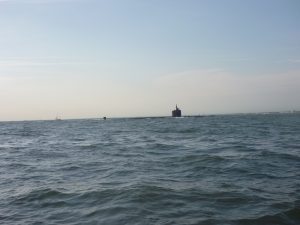 The harbor between Hampton and Norfolk is often filled with many different types of vessels. Today we saw a US Navy submarine approaching.
The harbor between Hampton and Norfolk is often filled with many different types of vessels. Today we saw a US Navy submarine approaching. We think we got a little closer than they may have been comfortable with and this nice Navy boat made sure he was between us and the sub. Yes, that is a big gun he is holding.
We think we got a little closer than they may have been comfortable with and this nice Navy boat made sure he was between us and the sub. Yes, that is a big gun he is holding. After this we then officially re-entered the Chesapeake Bay and celebrated the fact that there was wind and space to sail as we unrolled the genoa and enjoyed some motorsailing. Our friends were near us and were able to take a photo of us underway – it is very rare when we are able to get a photo of us under sail.
After this we then officially re-entered the Chesapeake Bay and celebrated the fact that there was wind and space to sail as we unrolled the genoa and enjoyed some motorsailing. Our friends were near us and were able to take a photo of us underway – it is very rare when we are able to get a photo of us under sail.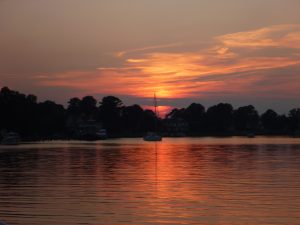

 In the harbor we saw two sailboats apparently playing “chicken” with the large cargo ship. There was no harm done, but we really do wonder what some people are thinking sometimes.
In the harbor we saw two sailboats apparently playing “chicken” with the large cargo ship. There was no harm done, but we really do wonder what some people are thinking sometimes.